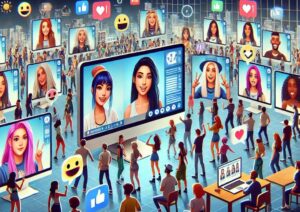The rise of social media has given birth to a new type of celebrity – the influencer. Powered by the reach of platforms like Instagram and TikTok, influencers have become a dominant force in marketing.
Brands partner with influencers to promote products to their loyal followers. However, one limitation is that most influencers only create content in one language, restricting their appeal to a single market.
This is where multilingual AI influencers come in. Developing influencers that can communicate in multiple languages could be the key to unlocking worldwide audiences.
Overcoming Language Barriers to Reach More Followers
The main appeal of AI influencers is the ability to automate content creation across multiple platforms. But even the most popular AI influencers are limited to English or their native language.
Creating multilingual versions opens up opportunities to engage with local followers in their native tongues. It helps build authentic relationships instead of expecting audiences to conform to another language.
For example, Imma Gram is a fictional AI influencer with almost 400,000 Instagram followers. Originally only posting images with English captions, Imma’s creators also realized her potential to connect with Spanish and Portuguese audiences. They built multilingual capabilities, allowing Imma to translate captions into the two additional languages. It helped her gain a global fanbase, increasing brand collaborations and sponsored content deals.
Key Takeaways:
- Multilingual content allows influencers to engage followers in their native language instead of excluding them.
- When you address audiences in their language, follower engagement and retention improve dramatically.
Benefits of Deploying Multilingual AI Influencers
Despite the challenges, successfully developing AI influencers that can operate in multiple global markets promises many benefits, such as:
- Localization – Followers appreciate content more when personalized to their local context than simply copying from other languages. Multilingual AI allows for tailored localization.
- Cultural Competence – When done thoughtfully, multilingual AI influencers can authentically align with the values of each culture they engage with. It builds credibility and connection.
- Global Revenue – Unlocking different markets opens up sponsorships, affiliate sales, and other monetization opportunities in those new languages.
- Wider Audience Reach – According to Statista 2023 report, approximately 1.459 billion Instagram users outside the United States. Multilingual AI lets brands connect with more of this worldwide fanbase.
Challenges in Developing Multilingual AI Influencers
Creating an AI influencer that can produce high-quality, natural-sounding content in multiple languages is extremely difficult. Here are some of the key technical hurdles faced when developing multilingual capabilities:
Natural Language Processing Across Languages
- Languages have inherent structural differences in grammar, word order, and sentence composition. Humans intuitively grasp these differences through experience.
- But AI requires massive datasets in each language along with deep neural networks to begin learning these nuances.
- For example, converting English grammar to Japanese requires adjusting sentence elements based on topic, context, formality, and other factors.
- Datasets need to contain diverse examples of language use across different genres, dialects, and contexts within each language.
- Pretrained multilingual AI models like mT5 and mBART show promise but still have a long way to go.
Challenges in Translation and Localization
- Direct word-for-word translation often fails to capture context, cultural meanings, and idioms accurately.
- Translators and localization experts must adapt content, humor, slang, and tone into a natural-sounding local language.
- Subtle regional dialects need to be accounted for. For example, Spanish in Mexico differs from that in Spain.
- References from pop culture that resonate in one culture may not be familiar in others. The jokes likely need adjusting.
Text-to-Speech Technology
- In addition to writing, influencers often create YouTube, TikTok, and Instagram videos. This requires text-to-speech, which is only sometimes accurate.
- Text-to-speech technology has to handle pronunciation, accent, intonation, and rhythm to sound human-like in each language.
- Perfecting TTS in multiple languages remains a challenge today.
Personality, Humor, and Relatability
- The influencer’s persona has to resonate across cultures. The challenge here is adding a human touch to their opinions, humor, and how they interact with the audience.
- What seems fun or engaging in English may translate poorly in different languages. Personality likely needs adjustment.
Strategies for Developing Effective Multilingual AI
Creating a persuasive and commercially successful multilingual AI influencer is a highly complex task that demands clever techniques to succeed. It is not just translating captions or outputs – the AI needs comprehensive multilingual capabilities and cultural customization.
Here are strategies to create a convincing and commercially viable multilingual AI influencer:
- Leverage Large, Diverse Multilingual Datasets –Train across multiple languages with vast amounts of diverse, multilingual data. Seek out datasets with various content types and geographic diversity. Data augmentation techniques can also generate additional examples. Leveraging pre-trained cross-lingual models like mT5 provides a helpful starting point.
- Refine with Native Speaker Inputs – Native speakers must thoroughly review all translated content. Fluent humans will identify errors and unnatural phrasing the AI generates. Incorporate this native speaker feedback into further model training to refine quality. This review is critical for achieving natural, engaging local language output.
- Customize Persona and Content to Each Culture – Customize the persona and content for cultural relevance. The influencer’s personality, humor, opinions, and pop culture references need adjustment for resonance in each market. Collaborate with local creators to guide nuanced cultural localization.
- Conduct Rigorous Testing Before Launch – Test before launch. Translated content and interactions should undergo peer review and market testing with target users in each language.
Incorporate insights from testing into additional content and model training iterations. Launch only once testing confirms multilingual solid performance across all languages.
Case Studies of Multilingual AI Influencers Finding Success
The following case studies showcase real-world examples of AI influencers who have successfully expanded their reach by launching multilingual capabilities. Their strategies and results demonstrate the significant audience growth and commercial opportunities unlocked by developing localized influencer content.
- Xiaoice from Microsoft: This chatbot was launched in China in 2014. She has over 660 million user interactions in Chinese, Japanese, Indonesian, and English. Xiaoice can converse on any topic through text or speech. Her ability to understand cultural context makes her interactions feel authentic and human-like.
- Imma Gram: As mentioned earlier, this fictional influencer posts lifestyle content tailored to English, Spanish, and Portuguese audiences on Instagram. Her captions in multiple languages allow cross-cultural connections with followers worldwide.
- Bermuda: This virtual musician was created by VR production company Anthropic. Bermuda has an entire backstory and discography of original songs. She can even duet live with human singers through multilingual speech generation.
The Future of Multilingual AI Influencers
Multilingual AI influencers are still in their infancy today. Still, rapid advances in language AI will soon unleash their full potential. Within a few years, we will see ultra-realistic virtual influencers fluent in dozens of languages. Their localized personalities and content will allow authentic emotional connections with diverse cultures globally.
Brands that leverage these technologies early can define the playbook and build lasting competitive advantage. This revolution will make content more inclusive for those locked out due to language barriers today. Multilingual AI influencers are just the beginning – soon, language will no longer be a limitation but a bridge to cross-cultural understanding.
However, thoughtful development and diligent testing are crucial as these influencers permeate worldwide social media. Without care, missteps could lead to ineffective or even dangerous miscommunications across languages. This technology can pioneer the path towards a shared global community if done responsibly.




